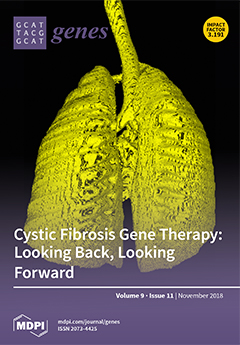Heparan sulfate proteoglycan 2 (
HSPG2) is an essential, highly conserved gene whose expression influences many developmental processes including the formation of the heart and brain. The gene is widely expressed throughout the musculoskeletal system including cartilage, bone marrow and skeletal muscle.
[...] Read more.
Heparan sulfate proteoglycan 2 (
HSPG2) is an essential, highly conserved gene whose expression influences many developmental processes including the formation of the heart and brain. The gene is widely expressed throughout the musculoskeletal system including cartilage, bone marrow and skeletal muscle. The
HSPG2 gene product, perlecan is a multifunctional proteoglycan that preserves the integrity of extracellular matrices, patrols tissue borders, and controls various signaling pathways affecting cellular phenotype. Given
HSPG2’s expression pattern and its role in so many fundamental processes, it is not surprising that relatively few gene mutations have been identified in viable organisms. Mutations to the perlecan gene are rare, with effects ranging from a relatively mild condition to a more severe and perinatally lethal form. This review will summarize the important studies characterizing mutations and variants of
HSPG2 and discuss how these genomic modifications affect expression, function and phenotype. Additionally, this review will describe the clinical findings of reported
HSPG2 mutations and their observed phenotypes. Finally, the evolutionary aspects that link gene integrity to function are discussed, including key findings from both in vivo animal studies and in vitro systems. We also hope to facilitate discussion about perlecan/
HSPG2 and its role in normal physiology, to explain how mutation can lead to pathology, and to point out how this information can suggest pathways for future mechanistic studies.
Full article






